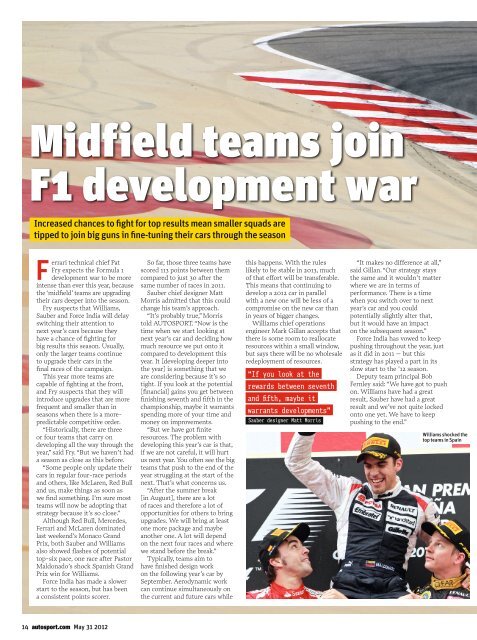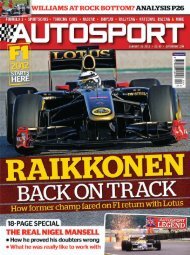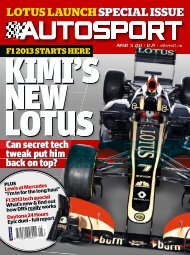REPORT MONACO gp - Mundo Motorizado
REPORT MONACO gp - Mundo Motorizado
REPORT MONACO gp - Mundo Motorizado
You also want an ePaper? Increase the reach of your titles
YUMPU automatically turns print PDFs into web optimized ePapers that Google loves.
Midfield teams join<br />
F1 development war<br />
increased chances to fight for top results mean smaller squads are<br />
tipped to join big guns in fine-tuning their cars through the season<br />
Ferrari technical chief Pat<br />
Fry expects the Formula 1<br />
development war to be more<br />
intense than ever this year, because<br />
the ‘midfield’ teams are upgrading<br />
their cars deeper into the season.<br />
Fry suspects that Williams,<br />
Sauber and Force India will delay<br />
switching their attention to<br />
next year’s cars because they<br />
have a chance of fighting for<br />
big results this season. Usually,<br />
only the larger teams continue<br />
to upgrade their cars in the<br />
final races of the campaign.<br />
This year more teams are<br />
capable of fighting at the front,<br />
and Fry suspects that they will<br />
introduce upgrades that are more<br />
frequent and smaller than in<br />
seasons when there is a morepredictable<br />
competitive order.<br />
“Historically, there are three<br />
or four teams that carry on<br />
developing all the way through the<br />
year,” said Fry. “But we haven’t had<br />
a season as close as this before.<br />
“Some people only update their<br />
cars in regular four-race periods<br />
and others, like McLaren, Red Bull<br />
and us, make things as soon as<br />
we find something. I’m sure most<br />
teams will now be adopting that<br />
strategy because it’s so close.”<br />
Although Red Bull, Mercedes,<br />
Ferrari and McLaren dominated<br />
last weekend’s Monaco Grand<br />
Prix, both Sauber and Williams<br />
also showed flashes of potential<br />
top-six pace, one race after Pastor<br />
Maldonado’s shock Spanish Grand<br />
Prix win for Williams.<br />
Force India has made a slower<br />
start to the season, but has been<br />
a consistent points scorer.<br />
14 autosport.com May 31 2012<br />
So far, those three teams have<br />
scored 113 points between them<br />
compared to just 30 after the<br />
same number of races in 2011.<br />
Sauber chief designer Matt<br />
Morris admitted that this could<br />
change his team’s approach.<br />
“It’s probably true,” Morris<br />
told AUTOSPORT. “Now is the<br />
time when we start looking at<br />
next year’s car and deciding how<br />
much resource we put onto it<br />
compared to development this<br />
year. It [developing deeper into<br />
the year] is something that we<br />
are considering because it’s so<br />
tight. If you look at the potential<br />
[financial] gains you get between<br />
finishing seventh and fifth in the<br />
championship, maybe it warrants<br />
spending more of your time and<br />
money on improvements.<br />
“But we have got finite<br />
resources. The problem with<br />
developing this year’s car is that,<br />
if we are not careful, it will hurt<br />
us next year. You often see the big<br />
teams that push to the end of the<br />
year struggling at the start of the<br />
next. That’s what concerns us.<br />
“After the summer break<br />
[in August], there are a lot<br />
of races and therefore a lot of<br />
opportunities for others to bring<br />
upgrades. We will bring at least<br />
one more package and maybe<br />
another one. A lot will depend<br />
on the next four races and where<br />
we stand before the break.”<br />
Typically, teams aim to<br />
have finished design work<br />
on the following year’s car by<br />
September. Aerodynamic work<br />
can continue simultaneously on<br />
the current and future cars while<br />
this happens. With the rules<br />
likely to be stable in 2013, much<br />
of that effort will be transferable.<br />
This means that continuing to<br />
develop a 2012 car in parallel<br />
with a new one will be less of a<br />
compromise on the new car than<br />
in years of bigger changes.<br />
Williams chief operations<br />
engineer Mark Gillan accepts that<br />
there is some room to reallocate<br />
resources within a small window,<br />
but says there will be no wholesale<br />
redeployment of resources.<br />
“If you look at the<br />
rewards between seventh<br />
and fifth, maybe it<br />
warrants developments”<br />
Sauber designer Matt Morris<br />
“It makes no difference at all,”<br />
said Gillan. “Our strategy stays<br />
the same and it wouldn’t matter<br />
where we are in terms of<br />
performance. There is a time<br />
when you switch over to next<br />
year’s car and you could<br />
potentially slightly alter that,<br />
but it would have an impact<br />
on the subsequent season.”<br />
Force India has vowed to keep<br />
pushing throughout the year, just<br />
as it did in 2011 – but this<br />
strategy has played a part in its<br />
slow start to the ’12 season.<br />
Deputy team principal Bob<br />
Fernley said: “We have got to push<br />
on. Williams have had a great<br />
result, Sauber have had a great<br />
result and we’ve not quite locked<br />
onto one yet. We have to keep<br />
pushing to the end.”<br />
Williams shocked the<br />
top teams in Spain













